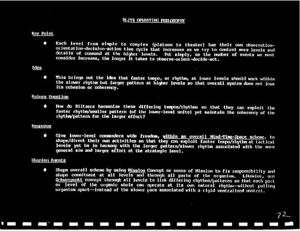Patterns of Conflict
| The works of |
| Works of John Boyd |
|---|
OODA WIKI Edition
Quantico Transcription
So looking into that, here’s a key point. Each level, from simple to complex, from platoon all the way up to theater, they all have their OODA loop or their OODA cycle.
But remember, the ones at the higher level are going to take much longer to go through. The ones at the lower level are working their way through those OODA loops a little bit quicker. So the higher up you go, you bring in more and more information, and longer time, in order to find out what the lower level is doing, so you can make your decision. All you’re doing is you’re
stretching out that OODA loop. I mean, it’s just natural. You can’t avoid it.
Okay. So it brings in the idea, this point here. How, in a sense, can you get the slower rhythm of the larger pattern operating with a faster rhythm with the lower pattern? Each one sort of has a certain rhythm or pace they’re operating at. They’re different, but how can we harmonize them?
So first point, raises question, how do blitzers harmonize these different tempos and rhythms?
Okay. So here’s my initial response. Now this is just an initial blast. We’re going to work our way through it so you can understand it.
First of all, you’ve got to give lower level commanders wide freedom within, that’s the key word within an overall mind-time-space scheme. In other words, everybody sort of has the same conceptual scheme. They have the same kind of a conceptual scheme through which they’re working through. And I don’t care whether you’re a squad, or whether you’re a commanding general of the theater, you’re all working within the same scheme.
Because if you’ve got one, the guy’s got another, is going to get very goddamn confused. Then you’ve got to issue detailed orders and everything stretches out. But there’s a danger, which we’ll get into later on. So that’s one point.
The second thing, you have to have shaping agents in order to implement that scheme. And the two that the Germans used here, I’ll go into more, is their mission concept, sometimes called their auftragstaktik or auftrag concept. And also the other one, they call the schwerpunkt. Shaping agents.
We’re still only getting to bloodshed. I want to go into it deeper. This is just the first turn on this. I want to give you a feeling for this. We talked about this last night. Okay? Now let’s go after it, after having taken that first plunge.
